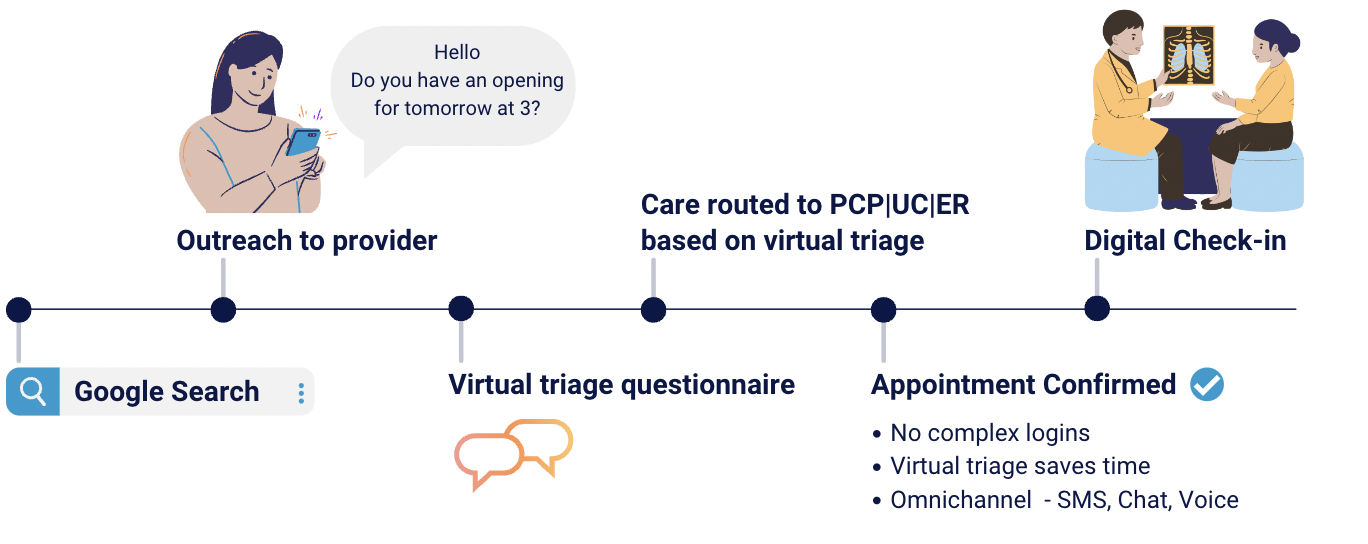
Patient-centered care is making big waves among healthcare organizations and hospitals. This type of care aims to respect and respond better to patients’ preferences, needs, and values and ensures patients are guided through all clinical decisions.
In truth, however, being patient-centric means more than just putting the patient’s needs at the center. It means utilizing modern tools to allow for smoother patient experiences by breaking the bastion of bureaucracy, shortening lines of communication, improving personalized care, and building more meaningful relationships with patients.
Let’s explore how automation and technology enable patient-centric care – transforming the healthcare industry in the Age of the Patient.
Patient-Centric Healthcare: Let's Deep Dive
Patient-centric care primarily aims to improve health outcomes for patients by providing more personalized care before, during, and after treatment to address psychological and social needs better during their health journey.
Patient-centered care typically includes:
Finding out what is essential to patients
Collaborating with patients by using patient communication, such as shared decision-making
Comforting and supporting patients by building relationships and empathy
Considering their non-clinical needs (like instructions or personalized follow-ups) as part of care.
The core goal of patient-centric care is building satisfaction and confidence, encouraging patients to see doctors regularly, and following advice and prescriptions diligently.
But that’s not all. Personalized care has immense secondary and tertiary benefits, like increased staff productivity and morale and decreased overall cost of care.
How Personalized Care Drives Patient Satisfaction
Finally, patient satisfaction is a primary driver of loyalty. Unfortunately, nearly three-quarters of people who switched healthcare providers in 2021 experienced poor healthcare navigation. This means those who put focus on better care experiences will get the chance to reduce patient churn in the long run.
Patient-centric care requires health systems to rethink how they deliver care by giving new attention to active collaboration and shared decision-making with patients. Sounds complicated?
Here are three practical steps healthcare organizations can take today👇
- Invest in The Healthcare Communication Model of the Future
One of the biggest goals in improving patient care is delivering more personalized and appropriate communication at all stages.
Naturally, patients have many questions before their first appointment, during treatment, and afterward. The sooner patients can resolve any inquiries they might have along the patient journey, the more satisfied they will be with their experience with you.
Patients are also interested in receiving information about clinical status, progress, and prognosis. If they are updated on their tests or x-rays, they can better navigate through their own health journey and make more informed decisions.
Unfortunately, long wait times or difficulty scheduling appointments affect the quality of care. By 2022, a typical patient must wait 20.6 days for a primary care appointment. Streamlining communication is, therefore, part of developing patient-centered care.
Digital tools like AI-powered chatbots and eScheduling can go a long way toward answering patient inquiries, reminding them of their appointments, helping them schedule and reschedule appointments, and ensuring someone checks in after their visits.

Automated communication tools are easy to employ and utilize, making them an excellent investment for any healthcare provider. And they have been proven successful: According to the Forrester Analytics Consumer Technographics survey data, 61% of online adults say they want to book/change their healthcare appointments with a website or app.
Streamlining communication is one side of patient-centered care; the other is getting patients to engage with you.
- Build Every Patient Interaction with a Value-Creation Mindset
Communication that reaches patients in their moment of need can be a critical factor in preventing an avoidable trip to the emergency room, a missed dose of medication, or a mental health patient’s distress. That’s why a key component of patient-centric care is better communication and care coordination between appointments and different services.
The goal is to help patients understand and learn about their health while making them feel heard when they have questions or concerns.
But to be able to do so, you need patients to be proactive. This means you need to create an environment giving patients the feeling their proactivity is welcome and wanted.
Here, 2-way communication tools are critical. Notifying or sending a message that prompts action by the patient will help deliver a culture where patients want to share their needs and concerns.
A good example is patient-driven rounding tools in hospitals that allow patients to voice their specific needs or concerns when they wish, without waiting for staff to come by.
Nudging patients with reminders can help avert no-shows, reduce the administrative burden, and lower costs. For example, one vendor in this Forrester survey found that a “5-3-1” -day reminder ratio works well to remind patients of upcoming appointments and reduces no-shows, confusion, and patient dissatisfaction.
- Data is key: Use feedback to personalize care
A final way to make care more patient-centered is to allow patients to give feedback. This has two benefits.
1. Patients must feel like their voices are being heard.
Digital tools guiding patients to utilize surveys, emails, or SMS allow you to remind them to leave information about how satisfied they are with their treatment, whether they would like to come back, and what specific concerns they would like addressed.
This real-time feedback also helps healthcare organizations uncover friction points in patient care, eliminate bottlenecks, and engage patients. For example, if wait times are an issue, surveys can identify critical control points to focus on.
2. Digital engagement helps you enhance patient relationships.
By forging this bond of communication and providing more personalized responses to questions, concerns, and treatment cycles, you will more easily understand patients’ priorities and be able to address them in the future.
As we’ve seen, patient-centered care requires a different approach in practices and using tools and digital aids. Planning communication, offering digital engagement, and building strong feedback loops ensure more patient-centered care and a more resilient future for your organization.
3. Personalize care with Steer Health
This is where patient experience and grown platforms like Steer Health can make a huge difference.
Steer Health understands patients’ needs and puts their well-being front and center. Learn more about how Steer Health can help you develop patient-centered care!









